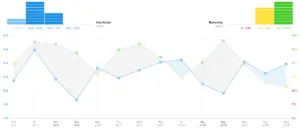Topics
- Article
‘Sleep is a Game Changer' – 9 Questions with Pitcher Ian Clarkin

We spoke with Chicago White Sox prospect Ian Clarkin (pictured as a high school senior in 2013) about being drafted, his goals for the year ahead, and what WHOOP does for him, including combatting the struggles of getting a good night’s sleep in minor league baseball.
You were selected 33rd overall by the New York Yankees in the first round of the 2013 MLB draft, what was that like?
“I went to the draft in New Jersey, I was projected to go anywhere from No. 10 overall to No. 20. I panicked a little bit when I started falling–I was sitting in the draft room during the TV broadcast and I couldn’t even get on a phone, so I was texting back and forth with my agent. It was a pretty stressful day to see my name drop a little bit further down than expected. I didn’t know when it was going to stop. The second I got picked was a big sigh of relief.
It was amazing though, it almost didn’t seem real, I just felt numb. In the moment, I didn’t really comprehend it, it all happened so fast. But in the next few days, it started to set in, ‘Oh my gosh, I just got drafted by the Yankees.’ I was kind of starstruck.”
When did you discover WHOOP?
“In 2016 when I was with the Yankees, there was a day where my trainer had a team meeting to talk about a new product called WHOOP. People were asking a ton of questions and I was really into it. I’ve always been an athlete who’s very curious about how my body works. In the past, I’ve fought injuries that I felt maybe could’ve been preventable by changing what I ate or how I slept. I wanted to get a handle on how to do things that are good for me specifically, not just the generalized process of what’s good and what’s bad.”
A post shared by Ian Clarkin (@ianclarkin) on Mar 22, 2017 at 5:17pm PDT
What were some of the first things you noticed about it?
“When I started wearing WHOOP, I began paying more attention to my heart rate variability and resting heart rate. I quickly learned about the things that affect your Recovery, like going to bed at a certain time, using your phone before you go to sleep, what and when you eat, not having a beer after a game, etc. I got to actually see what all of these things do to your body instead of just hearing ‘There’s science, there’s science, a study proved this, a study proved that…’ Now I had the information first hand.
I also realized that the days I put a ton of trauma [Strain] on my body were the days that I pitched. I’d probably throw 150-170 baseballs those days, between warming up in the bullpen and before innings, and pitching in the game. I used to wonder why I’d get terrible sleep the night after I pitched. So I started making adjustments, drinking more water those nights, no phone, no beer, getting to bed earlier–that was the biggest thing for me. I saw the effects of my better judgements in my WHOOP data. I fell in love with it real fast and I still wear it everyday.”
The adjustments Ian made included greatly reducing his cumulative Strain from things outside of baseball on the days he took the mound. Take a look at this two-week sample of his Strain (blue) and Recovery (green and yellow) data from last summer:

His two lowest-Strain days during this period were July 9 and July 16, also the two days he pitched. Ian posted great Recoveries on those days as well, including a 94% on July 16 when he surrendered just two earned runs and struck out seven batters in seven innings while earning a victory.
What’s it like trying to sleep on the road as a minor league ballplayer?
“The travel is pretty poor, we always ride on a bus. I’ve been on a bus that’s broken down and I’ve been on a bus with no AC driving through North Carolina in the middle of summer. Sometimes the bus trips are easy, other times they are extremely bad. When the games are over, no matter how long they last, you leave afterwards and get on the bus. It could be anywhere from 10 pm to 1 am and you might have a six or seven hour drive ahead of you.
That makes it really, really tough to sleep, and the quality is often terrible. I remember one ride to Lexington, KY, where we were stuck in traffic and got in at about 5 am for a 1 pm game that day. We had to try to sleep a couple hours, then wake up, get some breakfast and start the day.”
Is poor sleep a common issue players deal with?
“Absolutely, sleep is vital. You’ve got a game pretty much every single day, you get maybe two off days a month. I’ve learned playing in the minor leagues how important sleep is and that the earlier you can go to bed the better your rest is going to be. For example, you might be up till 2 am and sleep till 11 am and get nine hours of sleep, but that’s not the best nine hours of sleep you can get. From 9 am till 11 am you’re probably just trying to stay in bed and stay asleep [Editor’s note: Check out this story on The Locker about the benefits of sleep regularity].
I honestly think sleep in baseball is more important than diet, just about anything. WHOOP has helped me find the little keys, like what makes me fall asleep faster–no phone, AC on, etc,–what foods work best for me when I go to sleep and what makes the quality of my sleep better.”
You had some injury setbacks early in your pro career, do you think WHOOP might’ve helped you stay on the field?
“I definitely think it’s useful in terms of prevention. When I see a low Recovery I realize I have to take it easy, my body isn’t ready to pitch eight innings or throw 100 pitches. I know to ease up on those days so I don’t tweak or strain a muscle, or maybe even something worse. You want your body to always be in the best position possible. If you’re in the green, you can let it eat, you can go all out. It all leads back to the main component that you have to learn your body.”
Do you wish you’d had it when you were younger?
“I think [getting WHOOP] would’ve been the best thing I could’ve ever done, it would’ve changed the game for me in high school. For one thing, at that age you don’t realize the effects of the food you put in your body. I was a pasta and butter guy, I ate it every night just because I enjoy spaghetti. That obviously wasn’t the best thing for me. At the time, I really didn’t have a good understanding of how what goes into your body affects how you play the next day. And for the purposes of getting the highest quality sleep every night, it would’ve absolutely 100% changed the game for me.”
You played a role in the partnership between WHOOP and the NFLPA?
“I’m from San Diego, and a while back I did a charity event there with Darrell Stuckey of the Chargers. He quickly became one of my best friends. We’re always trying to give each other the edge to get better at our respective professions. I was at his house one day during the 2016-17 offseason and started talking to him about what WHOOP does for me. He said ‘Yeah, but my Fitbit does that.’ I said ‘No, no, it’s not even close.’ I told him with WHOOP, you get to see the quality of your sleep, not just how long you sleep. He joked ‘I don’t need to know about that, I don’t even sleep.’
The next time I went over there I kept pressing him, ‘Dude you’ve got to try this, this thing is awesome.’ Eventually his wife got him one for his birthday I think. He loved it right off the bat. After that, long story short, the NFLPA saw him wearing it and asked him what it was.”
Read Darrell’s story here: “Chargers’ Pro-Bowler Darrell Stuckey Talks WHOOP”
What’s your goal for the season ahead?
“I want to complete my dream, which means getting to the big leagues. And I don’t want to just get there, I want to stay there and succeed at that level. I set goals for myself every single day, that’s how you have to go about it. You can’t just say ‘I’m going to be a big leaguer this year,’ you have to actually do the things it takes to get there on a daily basis, like sleeping well, eating well, everything you can to maximize your performance.”